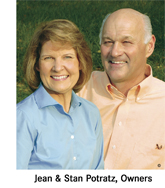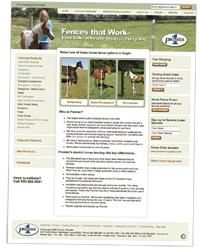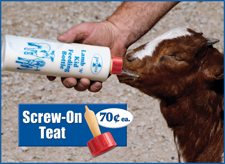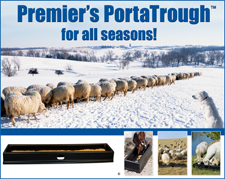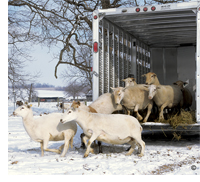Message from the Owner
Lessons learned at Premier while converting CRP land to sheep & cropsWe're responding to the economic crisis by gradually expanding our ewe flock from 200 to 600 in preparation for higher lamb prices from 2010 onwards. We purchased 240 extra acres late in 2007. Most of it is highly-erodible atypical Iowa land "pretty" but not the most productive. 140 acres has been in CRP for 20 years seeded variously to native grass (Indian grass & bluestem), low quality cool-season grass and pheasant food-crops (aka. foxtail). Our goal, over the coming years, is to convert 80% of this farm to sheep production with lamb as the saleable product. What have we done so far?
What sheep production system are we using on this land?
Results & evaluation: Lamb weaning % per ewe exposed was 155% in 2008 less than we need. However, this was year 1. We will get better at it as well our ewes. We noted that 25% of the Dorper-Romanov ewe lambs did not lamb at all (probably too young/small at breeding). The best lambs were from Katahdin and B. Leicesters ewes. Several outgrew our April-born lambs. Contributing factors were hybrid vigor and less exposure to internal parasites. A comment: For the first time in our history with sheep at Premier our flock developed an outbreak of infective conjunctivitis (pinkeye) in early winter. We fought it with antibiotics all winter to no avail. We finally gave up and allowed it to run its course. Up to 40% of our flocks (and their lambs) were affected. A few became blind. All affected suffered particularly during the summer as it attracted flies and gnats. 9 months later less than 2% are affected. What was its source? We assume it arrived with the ewes and/or rams we purchased last autumn (3 sources so a conclusion isn t possible). Our flock, which had been largely a closed flock prior to this, had no immunity or resistance (it does now!). It was an expensive experience and painful to observe. by Stan Potratz What's New
Now Live! - Premier's NEW Horse Fence Websitewww.horsefencesthatwork.com
You can still visit www.premier1supplies.com for all species and products. Special Price from Premier!
Screw-On Teat only 70¢(Remember: FREE SHIPPING on qualified website orders) This Screw-On Teat is a low cost option to Premier's Pritchard Teat Fits on Premier's Lamb 'n' Kid Feeding Bottle.
This offer cannot be combined with any other claim codes or offers. However, free shipping on qualified website orders still applies. Promo Codes: For phone orders: NEWSD Order soon! Offer expires November 30, 2008 or while supplies last!Premier Product
Premier's 5 ft. PortaTrough™Features:
Long enough to enable rapid feeding of sheep and short enough that 2 or more can easily be carried by hand or ATV. We find that it feeds about 8 adult sheep in full fleece (3 down each side and one on each end) and up to 10 adult goats. Premier Tip
Training Animals to Electric NettingFor electric net to be sucessful, new animals should be trained to electric net before sending them out to pasture. This helps create the pain barrier that temporary fence relies on to be effective. One way to train an animal is to put up the netting inside a permanent area for a day or so. (ie. a corral). Properly electrify the netting, that means making sure that there's at least 3000 to 4000 volts on the fence line (use our 6-Light Fence Tester). When the animal touches the fence they will learn that the netting causes pain and to stay away from it. When you then move them out to the field or timber they should recognize it as a pain barrier and will be less likely to test the fence. If you do not have a permanent area to train in, install the netting close to home so you can check the fence often to see if any animals have gotten tangled for the first week. Once they learn it is a pain barrier you should be ok to move the fence where needed. When netting is first installed, watch new animals for a couple hours to see how they react to the fence. With any electric fence check it often for any problems. Premier VIPRotational Grazing for Parasite Control-On a Budget!by Cherie Hall By now, anyone who's spent any amount of time searching for a way to beat the intestinal parasites that plague their goats in the warm season, has heard of Rotational Grazing. However, what many of these articles fail to address is the issue of the high cost of fencing and it's getting higher every day to purchase permanent steel fencing and posts. Before we relocated from California to Arkansas, we did not have much trouble controlling our goats' parasites. We spent our last three years in California running a vegetation management company called Goat Brushers Kikos. One benefit of the business was that our goats were rarely on the same piece of ground for more than two weeks out of the year! But on our new sixty-acre farm in Arkansas, we found that indeed, rotational grazing would be necessary if we intended to best utilize our pastures, keep the worm load down, and use a minimal amount of de-wormer. We determined that we need at least seven pens to do our rotational grazing properly, assuming that the buck pen is sparsely populated and large enough to allow the bucks to spread out and remain healthy. Following a "two weeks on/eight weeks off" schedule, as is often recommended, translates to five pens, plus the buck pen, plus an isolation pen for new arrivals or sick goats. But to convert an old cattle ranch into a goat ranch would involve a lot of fencing, just to fence the perimeter! Replacing or upgrading barbed wire and 6x6 field fencing to goat-proof barriers has and continues to be quite a challenge and quite an expense. We solved our fencing dilemma by approaching it from a few different angles. One step was to build a big, sturdy buck pen out of permanent fencing (sheep-and-goat fence, barbed wire, and hefty posts!) It encompasses about 4 acres of pasture, woodland, and pasture that is trying to reforest itself-perfect for browsing! It only lacks a hot wire at about 18 inches off the ground to discourage rubbing in the spring, and head-butting during the rutting season! The hot wire is one of this summer's scheduled projects. For the rest of the goats, we improved the permanent fencing on the "easiest" two sides of the property, and then began setting up temporary electric net fencing. After two years, we can see that some of our "favorite" or logical fence lines will eventually be permanent high-tensile electric fencing. Many of our fence lines are simply ElectroNet (purchased from Premier 1 Sheep Supply), including the side of the property that is only fenced by two strands of barbed wire over some very unforgiving terrain! These fence lines change frequently, as we experiment with the actual size of the "pens" to match the density of the vegetation, the time that the goats spend in the pen, and the nutritional needs of the goats. Once any brush is cleared initially, it takes a minimal amount of time on future setups to clear any weeds that may have re-grown. Another approach that has worked well for us is NEIGHBORS! We are smack dab in the middle of cattle country, so our goats were pretty much ignored by the old cattlemen in our local area. However, it didn't take long for the hay grower next-door to see that we had much fewer weeds, blackberries, and sapling re-growth in our pasture than he did. When he found out that we didn't use herbicides to control the broad-leaf growth, he commented that "we should throw a few goats in that old pen behind his house so he could clear out the trees for a pasture." And with that, like it or not, we were back in the brush-control business! Our herd of about twenty-five soon-to-be-meat bucklings finished off the two-acre parcel in less than two weeks. We did only minimal fence-repair before putting the bucklings in the overgrown mess, and because of the owner's barking dogs, suffered no predator losses while the goats were there. Another neighbor with about 400 acres and too much "woods" for his liking, heard about our small victory, and asked when we were going to put some goats at his ranch! His property shares our Eastern boundary, which makes moving the goats into that rotation a snap! We simply ran our push-type weed whacker along the existing fence on the North and South boundaries of his woodland (which was already fenced with barbed wire to keep his cattle out) and placed our electric fences alongside the barbed wire. We decided to exclude the cotton-mouth laden pond and swamp from the project area, so we did a bit of brush clearing across one end of the woods in order to avoid that problem! We cut out one section of barbed wire in our "shared" fence to allow the goats access, and we close the opening with a steel fence panel when we rotate them out. The goats have used this rotation twice this year. They will probably go back one more time in the late fall. Already, the owner can go in and finish cutting tree "tops" and firewood, eventually turning the area into a cattle pasture. He is impressed with how the goats eat the brambles, weeds, and debark the small trees, while leaving most of the grass that is taking over the clearings, untouched. He also likes being able to see where he's placing his feet-seems he doesn't like snakes, either! This same cattleman also had us put goats around some tree lines and brushy areas that stick into his hayfield, resembling the fingers on a glove. He wants to eventually end up with a "clear" square hayfield, with no intrusion from trees or brush. The goats made quick work of clearing out the deer brush, blackberries, brambles, and small cedar saplings that are trying to re-establish in the field. Although he was at first skeptical about having the goats "eat up all the grass," he was pleasantly surprised when the goats ate the plants that his cattle find unpalatable. We have enjoyed several benefits from our venture into rotational grazing. First, we are using "OPG" (that's Other People's Grass) which is always a good thing! As a direct benefit of that, we are saving our own pasture for hay, which we have just completed cutting and baling. We anticipate a second cutting if we don't need to use that pasture in our rotation. Secondly, by using the temporary fencing, which costs slightly less per foot than permanent fencing, we have delayed having to purchase permanent fencing for our entire property. Although we will eventually build more permanent fence, we have been able to spread the expense out over several years, while still using the land NOW. The net fences come complete with posts and connectors, making pasture-creation a quick project to complete. The hardest part is clearing the path, which is a much narrower path than necessary for erecting a permanent wire fence. Plus, no digging! When the ground is hard and dry, we use a special long-shanked drill bit on a cordless drill, to pre-drill the holes in the baked clay-but that is not needed for most of the summer around most of our property. Thirdly, we do not need to purchase additional chargers as long as we can run the temporary electric in such a manner as to be able to hook it to the existing electric fences with "underground wire." While we have purchased a solar-powered fence charger (on close-out from a large feed store) to use on remote pastures, we can usually run all the fences off the permanent charger in the shed. We run about 11,000 volts on the fence, and find that anything less than 5,000 volts is asking for trouble with goats! Some additional notes on the fencing itself: From our personal experience, we have discovered that different fences are appropriate for different situations, but that one CAN make one or two types of fence fit most jobs. For example, we have purchased Premier's product called "PermaNet." This is a tall, heavy, all-positive net fence. For permanent applications, i.e., fences that will remain in place for longer than a month, and/or can be sprayed with an herbicide while in place, it is a good choice. We do find it to be less rigid and prone to sagging, more so than some other types of electric net fencing, and the weight makes it harder to move frequently. However, we have successfully used it to separate two herds of breeding does and their respective bucks! Our "favorite" and most-often used type of fencing is ElectroNet 9/35/12 Pos-neg. This fence is "short"-only 35 inches tall. But it does the job of keeping goats, kids, and dogs convinced that this is, indeed, the boundary! With this fence there is also the option of running it "all hot," i.e., every horizontal wire is hot/positive, OR running it Pos-Neg, i.e., alternating horizontal wires are positive or negative. This application is best used when the earth is dry or rocky, thereby making a good shock less likely. The animal is shocked by touching either the positive wire, or by touching the positive and negative wires simultaneously as they stick their nose through the fence. We make the fence all-positive (by simply joining the two end-clips together) to train kids and new goats to the fence. This fence is also available in an all-hot version, but we prefer to pay the additional roughly $40 for the more versatile model. This same fence is available in a 42" tall version, called ElectroStop, in both all-positive and Pos-Neg versions-but the small additional height, coupled with the extra weight and resulting difficulty of carrying it through heavy brush, make it our second choice for fencing. There are also the issues of higher price and problems with sagging that require the use of additional step-in posts. For certain applications, such as goats that jump fences, or to traverse uneven terrain, hills, slopes, dips and such, this fence coupled with step-in posts might be your best option. Electric netting is also available in a half-length version (82 feet long roll as opposed to 164 foot long roll) and a nifty 20-foot long all-positive "gate," both of which have earned a place on our storage rack! Please note that the comments regarding the suitability of the various types of netting sold by Premier are based on our personal experiences, and are meant to guide the reader to the most appropriate choice for their particular application. These comments are not in any way a negative reflection on the quality of their products. On the contrary, we have used other brands of electric fencing, and have returned to Premier's products as being superior for our applications. A fourth benefit we have enjoyed from using rotational grazing is that our goats enjoy being let into nearly parasite-free pastures and fresh-grown browse above the ground, instead of being kept in the cesspool of invisible (to us) larvae and eggs found when using a single pasture. The health benefits are obvious, as is their delight when moving into a "new" pasture. They actually RUN into each new area when we let them in-do they know the new area is GOOD for them, or is it just the thrill of the newness? And last but not least, we have been able to show our neighbors by example, that the goats can help the cattlemen achieve the type of pasture they desire--removing weeds, brush, and sapling re-growth that heretofore needed to be cleared biannually with a bush-hog, which required diesel fuel! The cattlemen understand pasture rotation, and to bring their cattle back into an area that not only has more grass, but fewer cattle-born intestinal parasites, is truly a WIN-WIN situation. It certainly hasn't hurt our bottom line, and when you're a goat farmer, saving money is a beautiful and NECESSARY thing. Dr. Jodie Pennington from the University of Arkansas visited our ranch this spring, as part of his research on Co-Species Grazing. Watch for his upcoming study. We will be doing a hands-on demonstration on how we use electric fencing, at the 2008 IKGA Kikofest in Gray, TN, September 17-20, 2008. If you would like more information on our fencing methods, suppliers, or our upcoming demonstration, please contact us, the IKGA http://www.theikga.org/, or come to Kikofest 2008! Article by Cherie Hall Premier Employee Spotlight
Jamie BoshartJamie Boshart of Washington, IA is this month's featured employee. She works in our shipping department and has been with us for just under a year. She says "that she likes that nothing is ever the same, everyday is always something new. I also get along well with the others I work with in the shipping department and that is really nice." About Premier she says, "I really like how everyone gets along with one another. It's a great solid family based company." Jamie lives at home with her mom and dad, two older sisters, two dogs named Chase and Missy and a cat named Bud. When not at work she likes to get a little bit adventuresome with her friends riding 4-wheelers and motorcycles. She also enjoys family time at their cabin on Lake Odessa in southeast Iowa. She comments that her favorite statement is "I didn't do it!" Remember that she is the youngest of three and also the youngest here at Premier. RecipeCrock Pot Chicken & MushroomsIngredients: 6 to 10 chicken leg quarters or thighs (skin removed) In a medium bowl, mix cream of mushroom soup, can of mushrooms, chicken broth and sour cream. Set aside. After removing skin, place chicken in bottom of crock pot. Sprinkle with paprika, lemon pepper and salt. Pour mixture over chicken. Cook on low for 6 to 8 hours. Serve over egg noodles or rice. from Fawn Blodgett, Premier employee |


